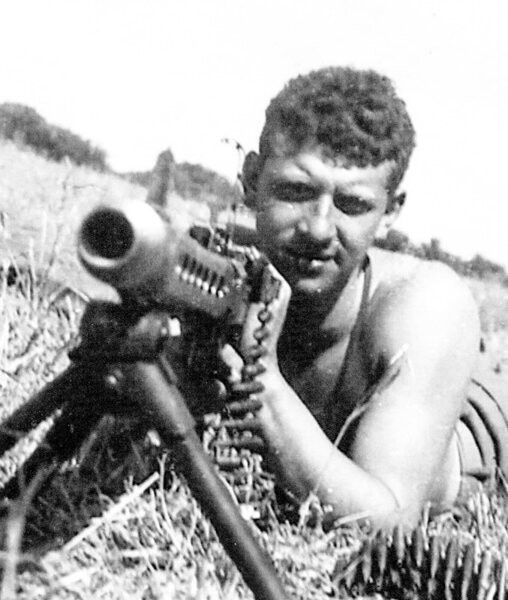Jack Masey

CPL in 603rd Engineer Camouflage Bn : Co B, 2nd Platoon
Born 1924 in NY, Died 2016
Artist
Other residence(s): Brooklyn, NY
United States Army, European Theatre of Operations
College education before the war: Cooper Union
College education after the war: Yale
Jack Masey was born on June 10, 1924 in Brooklyn, NY, the younger of two children. His parents had both been born in Russia. His father had been gassed in World War I (as a member of the US forces) and worked only sporadically as a house painter; his mother was a seamstress.
He had enjoyed drawing as a child and was good at it. He drew the things he saw—the factory across the street, the roofs he could see from his family's windows. Encouraged by a teacher, he gained entry into the newly created High School of Music and Art, from which he graduated in 1942. He then went to work, taking courses at Cooper Union at night.
He registered for the draft a few weeks after his 18th birthday, on June 30, 1942. As an artist, he found himself in the 603rd Engineer Camouflage Battalion. About his wartime experience Jack said: "The inflatables I loved. I had fun during World War II." Like other artists in the 603rd, Jack kept busy practicing his craft during down times—in his case, caricatures of his fellow soldiers. Towards the end of the war, he and his buddies chipped in some money, found a printer in Luxembourg, and produced 150 copies of a book of the caricatures entitled You on KP—one for every member of their company. They autographed each other's books and saved them as souvenirs.
Jack was discharged from the Army in 1945 with the rank of CPL, and set about making post-war plans. According to a 1949 article in the Brooklyn Daily Eagle, he "worked with Norman Bel Geddes on a model project of the battle of Midway Island, then got a summer job with the Architectural Forum as assistant director of the magazine." Applying for entrance into the Yale University School of Fine Arts, "he skipped the hard questions on his application blank and drew a picture on it." He was accepted, and received his BFA in 1950, with concentrations in architecture and graphic design. By then he already had a national presence—Esquire magazine published a series of his caricatures of well-known performers (including Al Jolson and Eddie Cantor) in the summer of 1949.
After Yale, he went to work for a Manhattan architect, but was recruited a year later by the State Department to stage trade exhibits worldwide for the U.S. Information Agency. He was the Chief of Design for the 1959 American exhibition in Moscow that famously became the site of the "kitchen debate" between Nixon and Khrushchev. According to his obituary in the New York Times, he "presented a kinetic picture of American art, science and industry, and the daily life of ordinary American citizens, to audiences around the world, many of them, during the Cold War years, deeply suspicious of American culture and foreign policy."
"He made a point of engaging top architects and designers, including R. Buckminster Fuller and Charles and Ray Eames, to come up with imaginative buildings and sets to showcase nontraditional exhibition materials." These included fashion shows, films, modern art, movie props, electric appliances, and talking chickens.
For Expo '67 in Montreal, Jack filled Buckminster Fuller's geodesic dome with space technology and the arts. He also got some of his Ghost Army buddies to help out. Bill Blass designed the guide uniforms, Ellsworth Kelly's art was displayed, and Art Kane prepared a film.
The USIA loaned him to the American Revolution Bicentennial Commission in the 1970s to direct its bicentennial park program nationwide.
Jack left the State Department in 1979 and, with the designers Ivan Chermayeff and Tom Geismar, founded Metaform Design International. The company's projects included exhibitions at the Ellis Island National Museum of Immigration, the Statue of Liberty, the Truman Library in Independence, MO, the National World War II Museum in New Orleans, and the Johnstown (PA) Flood Museum. He never retired from Metaform.
Jack's first wife, Mary Lou, died in 1991. In 2003, he married Beverly Payeff.
He was the author, with Conway Lloyd Morgan, of Cold War Confrontations: US Exhibitions and Their Role in the Cultural Cold War, published in 2008.
Throughout the years, people talked about Jack in similar terms. "He's swell with people!" said his sister in that 1949 article. His wife Beverly spoke of his "full-throated enthusiasms" and the way he loved people "deeply in that big outrageous Masey way." And, in a 2016 tribute, Rick Beyer wrote that "rarely have I met anyone who radiated such infectious energy and enthusiasm. . . . Most of all, he was a person who gave enthusiastically of himself to others."
He died on March 13, 2016 in Manhattan.
Want to know more? Watch the Rick Beyer interview of Jack Masey.
Sources:
1930 census
1942 draft card
1949 article in Brooklyn Daily Eagle about his experiences during the war and at Yale
https://www.newspapers.com/image/686244966/?terms=jack%20masey&match=1
1960 airplane passenger manifest Paris to NY
1972 article in Lansing State Journal (MI) re his work as design director for American Revolution Bicentennial Commission
https://www.newspapers.com/image/206157439/?terms=jack%20masey&match=1
1984-1993 US public records index
1995 article in the Kansas City Star re his redesign of Truman Library
https://www.newspapers.com/image/683726141/?terms=jack%20masey&match=1
2003 2nd marriage record
2008 interview in The Guardian
https://www.theguardian.com/artanddesign/2008/sep/18/design.jackmasey
2016 Find a Grave record
https://www.findagrave.com/memorial/254687449/jack-massey
2016 obituary in The Architect's Newspaper
2016 obituary in the New York Times
2016 Rick Beyer's remembrance of Jack Masey
http://rickbeyer.blogspot.com/2016/03/0-0-1-747-4261-plate-of-peas.html